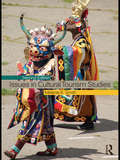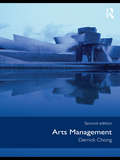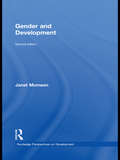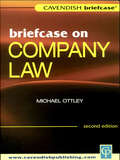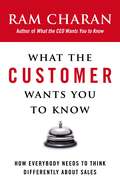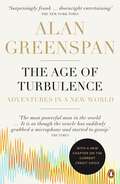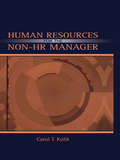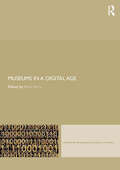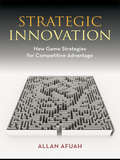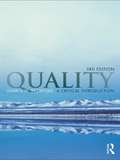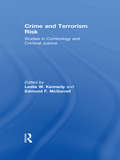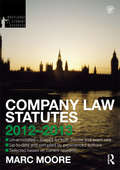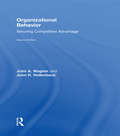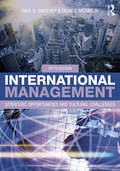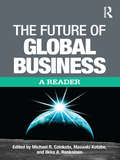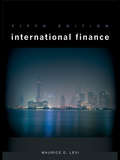- Table View
- List View
Issues in Cultural Tourism Studies
by Melanie K. SmithThe extensively revised second edition of Issues in Cultural Tourism Studies provides a new framework for analyzing the complexity of cultural tourism and its increasing globalization in existing as well as emergent destinations of the world. The book will focus in particular on the need for even more creative tourism strategies to differentiate destinations from each other using a blend of localized cultural products and innovative global attractions. The book explores many of the most pertinent issues in heritage, arts, festivals, indigenous, ethnic and experiential cultural tourism in urban and rural environments alike. This includes policy and politics; impact management and sustainable development; interpretation and representation; marketing and branding; and regeneration and planning. As well as exploring the inter-relationships between the cultural and tourism sectors, local people and tourists, the book provides suggestions for more effective and mutually beneficial collaboration. New edition features include: an increased number of topical case studies and contemporary photographs which serve to contextualize the issues discussed a re-orientation towards global rather than just European issues three brand new chapters on The Geography of Cultural Tourism, The Politics of Global Cultural Tourism, and The Growth of Creative Tourism an extensively revised chapter on Experiential Tourism. At the interface between the global and the local, a people-centred approach to planning and development is advocated to ensure that benefits are maximized for local areas, a sense of place and identity are retained, and the tourist experience is enhanced to the full. The text is unique in that it provides a summary and a synthesis of all of the major issues in global cultural tourism, which are presented in an accessible way using a diverse range of international case studies. This is a beneficial and valuable resource for all tourism students.
Arts Management
by Derrick ChongThe second edition of Arts Management has been thoroughly revised to provide an updated, comprehensive overview of this fast-changing subject. Arts managers and students alike are offered a lively, sophisticated insight into the artistic, managerial and social responsibilities necessary for those working in the field. With new cases studies and several new chapters, Derrick Chong takes an interdisciplinary approach in examining some of the main impulses informing discussions on the management of arts and cultural organizations. These are highly charged debates, since arts managers are expected to reconcile managerial, economic and aesthetic objectives. Topics include: arts and the State, with reference to the instrumentalism of the arts and culture business and the arts ownership and control of arts organizations arts consumption and consumers, including audience development and arts marketing managing for excellence and artistic integrity financial investing in the arts, namely fine arts funds and theatre angels philosophies of philanthropy Incorporating a deliberately diverse range of sources, Arts Management is essential reading for students on arts management courses and provides valuable insights for managers already facing the management challenges of this field.
Arts Management
by Derrick ChongThe second edition of Arts Management has been thoroughly revised to provide an updated, comprehensive overview of this fast-changing subject. Arts managers and students alike are offered a lively, sophisticated insight into the artistic, managerial and social responsibilities necessary for those working in the field. With new cases studies and several new chapters, Derrick Chong takes an interdisciplinary approach in examining some of the main impulses informing discussions on the management of arts and cultural organizations. These are highly charged debates, since arts managers are expected to reconcile managerial, economic and aesthetic objectives. Topics include: arts and the State, with reference to the instrumentalism of the arts and culture business and the arts ownership and control of arts organizations arts consumption and consumers, including audience development and arts marketing managing for excellence and artistic integrity financial investing in the arts, namely fine arts funds and theatre angels philosophies of philanthropy Incorporating a deliberately diverse range of sources, Arts Management is essential reading for students on arts management courses and provides valuable insights for managers already facing the management challenges of this field.
Gender and Development (Routledge Perspectives on Development)
by Janet MomsenGlobal financial problems, rising food prices, climate change, international migration – increasingly by women – conflict situations in many poor countries, the spread of tropical diseases such as malaria and dengue fever and the increased incidence of HIV/AIDS and TB, and changing patterns of trade have all added new dimensions to gender issues in developing countries. These problems are frequently being brought to public attention in the media and through long-haul tourism. Consequently students’ interest in gender and development has grown considerably in the last few years. This updated second edition provides a concise, accessible introduction to Gender and Development issues in the developing world and in the transition countries of Eastern and Central Europe. The nine chapters include discussions on changes in theoretical approaches, gender complexities and the Millennium Development Goals; social and biological reproduction including differing attitudes to family planning by states and variation in education and access to housing; differences in health and violence at major life stages for women and men and natural disasters and gender roles in rural and urban areas. The penultimate chapter considers the impact of broad economic changes such as the globalization of trade and communications on gender differences in economic activity and the final chapter addresses international progress towards gender equality as measured by the global gender gap. The text is particularly strong on environmental aspects and the new edition builds on this to consider the effects of climate change and declining natural resources illustrated by a case study of changing gender roles in fishing in India. There is also enhanced coverage of topics such as global trade, sport as a development tool, masculinities, and sustainable agriculture. Maps, statistics, references and boxed case studies have been updated throughout and their coverage widened. Gender and Development is the only broad based introduction to the topic written specifically for a student audience. It features student friendly items such as chapter learning objectives, discussion questions, annotated guides to further reading and websites. The text is enlivened throughout with examples and case studies drawn from the author’s worldwide field research and consultancies with international development agencies over four decades and her experience of teaching the topic to undergraduates and postgraduates in many countries. It will be an essential text for a variety of courses on development, women’s studies, sociology, anthropology and geography.
Gender and Development (Routledge Perspectives on Development)
by Janet MomsenGlobal financial problems, rising food prices, climate change, international migration – increasingly by women – conflict situations in many poor countries, the spread of tropical diseases such as malaria and dengue fever and the increased incidence of HIV/AIDS and TB, and changing patterns of trade have all added new dimensions to gender issues in developing countries. These problems are frequently being brought to public attention in the media and through long-haul tourism. Consequently students’ interest in gender and development has grown considerably in the last few years. This updated second edition provides a concise, accessible introduction to Gender and Development issues in the developing world and in the transition countries of Eastern and Central Europe. The nine chapters include discussions on changes in theoretical approaches, gender complexities and the Millennium Development Goals; social and biological reproduction including differing attitudes to family planning by states and variation in education and access to housing; differences in health and violence at major life stages for women and men and natural disasters and gender roles in rural and urban areas. The penultimate chapter considers the impact of broad economic changes such as the globalization of trade and communications on gender differences in economic activity and the final chapter addresses international progress towards gender equality as measured by the global gender gap. The text is particularly strong on environmental aspects and the new edition builds on this to consider the effects of climate change and declining natural resources illustrated by a case study of changing gender roles in fishing in India. There is also enhanced coverage of topics such as global trade, sport as a development tool, masculinities, and sustainable agriculture. Maps, statistics, references and boxed case studies have been updated throughout and their coverage widened. Gender and Development is the only broad based introduction to the topic written specifically for a student audience. It features student friendly items such as chapter learning objectives, discussion questions, annotated guides to further reading and websites. The text is enlivened throughout with examples and case studies drawn from the author’s worldwide field research and consultancies with international development agencies over four decades and her experience of teaching the topic to undergraduates and postgraduates in many countries. It will be an essential text for a variety of courses on development, women’s studies, sociology, anthropology and geography.
Briefcase on Company Law (Briefcase Series)
by MIchael OttleyThe Briefcase series is designed specifically with the time-pressed student in mind. It provides concise case summaries within each subject area of an undergraduate law degree, accompanied by relevant legislation. A handy reference tool, the book assists the reader to commit the content of each subject to memory. This title covers the four main areas of company law: the constitution, formation and personality of a company; corporate governance; corporate finance; and insolvency and company charges. The second edition has been updated to include recent important cases, including the House of Lords decision in Johnson v Gore Wood - (minority shareholder action) Phillips v Brewin Dolphin Bell Lawrie Ltd - (transactions at an undervalue) O'Neill v Phillips - (unfair prejudicial conduct) Williams v Natural Life Health Foods Ltd - (liability in negligence) the Privy Council decision in Agnew v Commissioner of Inland Revenue - (company charges).
Briefcase on Company Law (Briefcase Series)
by MIchael OttleyThe Briefcase series is designed specifically with the time-pressed student in mind. It provides concise case summaries within each subject area of an undergraduate law degree, accompanied by relevant legislation. A handy reference tool, the book assists the reader to commit the content of each subject to memory. This title covers the four main areas of company law: the constitution, formation and personality of a company; corporate governance; corporate finance; and insolvency and company charges. The second edition has been updated to include recent important cases, including the House of Lords decision in Johnson v Gore Wood - (minority shareholder action) Phillips v Brewin Dolphin Bell Lawrie Ltd - (transactions at an undervalue) O'Neill v Phillips - (unfair prejudicial conduct) Williams v Natural Life Health Foods Ltd - (liability in negligence) the Privy Council decision in Agnew v Commissioner of Inland Revenue - (company charges).
What the Customer Wants You to Know: How Everybody Needs to Think Differently About Sales (Playaway Adult Nonfiction Ser.)
by Ram CharanAccording to business guru Ram Charan, the process of selling is broken. Demand for competitive pricing is ever on the increase, and customers want more than great products at great prices; they want you to know how their business works, so that you can make it work better. It is time for companies to re-think their selling processes, and that's where Charan's concept of Value Creation Selling fits in. It is a new approach that while radical is nonetheless practical and produces stronger customer relationships and long term rewards. VCS will enable you to:Gain a deeper knowledge of your customer's businessUse this knowledge to improve your customer's marginsShow how your product and expertise is a winning combinationSomeday, every company will listen more closely to the customer. In the meantime, this eye opening book will show you how to get ahead of the competition.
The Age of Turbulence: Adventures in a New World
by Alan GreenspanThe most remarkable thing that happened to the world economy after 9/11 was ... nothing. What would have once meant a crippling shock to the system was absorbed astonishingly quickly, partly due to the efforts of the then Chairman of the Federal Reserve Board, Alan Greenspan.The post 9/11 global economy is a new and turbulent system - vastly more flexible, resilient, open, self-directing, and fast-changing than it was even twenty years ago. The Age of Turbulence is an incomparable reckoning with the nature of this new world - how we got here, what we're living through, and what lies over the horizon, for good or ill, channelled through Greenspan's own experiences working in the command room of the global economy for longer and with greater effect than any other single living figure.
Human Resources for the Non-HR Manager
by Carol T. Kulik Carol T Kulik Elissa PerryHuman Resources for the Non-HR Manager appeals to anyone interested in management issues. The book explains why human resource issues are increasing the responsibilities of front-line managers rather than the HR department. Chapters present the basics of HR including the fundamentals of hiring, performance appraisal, reward systems, and disciplinary systems, so that any manager--regardless of his or her background or functional area--can approach these parts of the job with confidence. The book also covers the latest developments in equal opportunity law and describes the manager's responsibilities in controlling sexual harassment and managing diverse employees, including older workers and employees with disabilities. Each chapter's material is firmly grounded in the current HR academic literature, but the book's friendly, conversational tone conveys basic principles of good practice without technical jargon. Designed to make the material more accessible and personally relevant, the book includes the following special features:*Manager's Checkpoints--a series of questions that help the reader apply the material to his or her own organizational context; *Boxes that describe real-life examples of how companies respond to HR challenges;*For Further Reading--references to articles published in outlets that bridge the academic-practitioner divide;*Manager's Knots--presented in a question-and-answer format, these describe typical managerial problems, take the reader into some of the gray, ambiguous areas of HR, and suggest ways to apply the chapter material to real-life managerial dilemmas.
Museums in a Digital Age (Leicester Readers in Museum Studies)
by Ross ParryThe influence of digital media on the cultural heritage sector has been pervasive and profound. Today museums are reliant on new technology to manage their collections. They collect digital as well as material things. New media is embedded within their exhibition spaces. And their activity online is as important as their physical presence on site. However, ‘digital heritage’ (as an area of practice and as a subject of study) does not exist in one single place. Its evidence base is complex, diverse and distributed, and its content is available through multiple channels, on varied media, in myriad locations, and different genres of writing. It is this diaspora of material and practice that this Reader is intended to address. With over forty chapters (by some fifty authors and co-authors), from around the world, spanning over twenty years of museum practice and research, this volume acts as an aggregator drawing selectively from a notoriously distributed network of content. Divided into seven parts (on information, space, access, interpretation, objects, production and futures), the book presents a series of cross-sections through the body of digital heritage literature, each revealing how a different aspect of curatorship and museum provision has been informed, shaped or challenged by computing. Museums in a Digital Age is a provocative and inspiring guide for any student or practitioner of digital heritage.
Museums in a Digital Age: Museums In A Digital Age (Leicester Readers in Museum Studies)
by Ross ParryThe influence of digital media on the cultural heritage sector has been pervasive and profound. Today museums are reliant on new technology to manage their collections. They collect digital as well as material things. New media is embedded within their exhibition spaces. And their activity online is as important as their physical presence on site. However, ‘digital heritage’ (as an area of practice and as a subject of study) does not exist in one single place. Its evidence base is complex, diverse and distributed, and its content is available through multiple channels, on varied media, in myriad locations, and different genres of writing. It is this diaspora of material and practice that this Reader is intended to address. With over forty chapters (by some fifty authors and co-authors), from around the world, spanning over twenty years of museum practice and research, this volume acts as an aggregator drawing selectively from a notoriously distributed network of content. Divided into seven parts (on information, space, access, interpretation, objects, production and futures), the book presents a series of cross-sections through the body of digital heritage literature, each revealing how a different aspect of curatorship and museum provision has been informed, shaped or challenged by computing. Museums in a Digital Age is a provocative and inspiring guide for any student or practitioner of digital heritage.
Strategic Innovation: New Game Strategies for Competitive Advantage
by Allan AfuahIn today’s fast-changing business environment, those firms that want to remain competitive must also be innovative. Innovation is not simply about developing new technologies into new products or services, but in many cases, finding new models for doing business in the face of change. It often entails changing the rules of the game. Strategic Innovation demonstrates to students how to create and appropriate value using new game strategies to gain competitive advantage. The book begins with a summary of the major strategic frameworks and showing the origins of strategic innovation. Next, Afuah gives a thorough examination of contemporary strategy from an innovation standpoint, including: how to develop strategy in the face of change a detailed framework for assessing the profitability potential of a strategy or product consideration of how both for-profit and non-profit organizations can benefit from new game strategies. With a wealth of quantitative examples of successful strategies, as well as descriptive cases, Strategic Innovation will complement courses in strategy, and technology and innovation.
Quality: A Critical Introduction, Third Edition
by John BeckfordThe 3rd edition of this top-selling text continues to provide a complete knowledge platform for all those wishing to study the development of the theory and practice of quality management. Building upon previous editions’ unique critical perspective on quality, this edition is enhanced by the inclusion of the latest contemporary developments in quality thinking, including Integrated Management Systems, Lean Manufacturing and SMART thinking, as well as updated, real-world examples in applying quality methods. In addition, existing understanding of the environmental impact of the quality movement will be extended into a broader understanding of environmental, financial, regulatory and behavioral sustainability. The book also addresses the issues of Corporate Governance and Corporate Social Responsibility which are now informing the decision making and behavior of managers. Key features include: Complete introduction to quality in the context of management thinking In depth reviews of the contributions of ‘Quality Gurus’ Contemporary developments in theory and practice International case studies drawn from both public and private sectors Equal emphasis on both manufacturing and service sectors Practical ‘case study’ focused toolkits and applications
Quality: A Critical Introduction, Third Edition
by John BeckfordThe 3rd edition of this top-selling text continues to provide a complete knowledge platform for all those wishing to study the development of the theory and practice of quality management. Building upon previous editions’ unique critical perspective on quality, this edition is enhanced by the inclusion of the latest contemporary developments in quality thinking, including Integrated Management Systems, Lean Manufacturing and SMART thinking, as well as updated, real-world examples in applying quality methods. In addition, existing understanding of the environmental impact of the quality movement will be extended into a broader understanding of environmental, financial, regulatory and behavioral sustainability. The book also addresses the issues of Corporate Governance and Corporate Social Responsibility which are now informing the decision making and behavior of managers. Key features include: Complete introduction to quality in the context of management thinking In depth reviews of the contributions of ‘Quality Gurus’ Contemporary developments in theory and practice International case studies drawn from both public and private sectors Equal emphasis on both manufacturing and service sectors Practical ‘case study’ focused toolkits and applications
Crime and Terrorism Risk: Studies in Criminology and Criminal Justice
by Leslie W. Kennedy Edmund F. McGarrellCrime and Terrorism Risk is a collection of original essays and articles that presents a broad overview of the issues related to the assessment and management of risk in the new security age. These original articles show how researchers, experts and the public are beginning to think about crime and terrorism issues in terms of a new risk paradigm that emphasizes establishing a balance between threat and resources in developing prevention and response strategies.
Company Law Statutes 2012-2013 (Routledge Student Statutes)
by Marc Moore‘Focused content, layout and price - Routledge competes and wins in relation to all of these factors’ - Craig Lind, University of Sussex, UK ‘The best value and best format books on the market.’ - Ed Bates, Southampton University, UK Routledge Student Statutes present all the legislation students need in one easy-to-use volume. Developed in response to feedback from lecturers and students, this book offers a fully up-to-date, comprehensive, and clearly presented collection of legislation - ideal for LLB and GDL course and exam use. Routledge Student Statutes are: • Exam Friendly: un-annotated and conforming to exam regulations • Tailored to fit your course: 80% of lecturers we surveyed agree that Routledge Student Statutes match their course and cover the relevant legislation • Trustworthy: Routledge Student Statutes are compiled by subject experts, updated annually and have been developed to meet student needs through extensive market research • Easy to use: a clear text design, comprehensive table of contents, multiple indexes and highlighted amendments to the law make these books the most student-friendly Statutes on the market Competitively Priced: Routledge Student Statutes offer content and usability rated as good or better than our major competitor, but at a more competitive price • Supported by a Companion Website: presenting scenario questions for interpreting Statutes, annotated web links, and multiple-choice questions, these resources are designed to help students to be confident and prepared.
Company Law Statutes 2012-2013 (Routledge Student Statutes)
by Marc Moore‘Focused content, layout and price - Routledge competes and wins in relation to all of these factors’ - Craig Lind, University of Sussex, UK ‘The best value and best format books on the market.’ - Ed Bates, Southampton University, UK Routledge Student Statutes present all the legislation students need in one easy-to-use volume. Developed in response to feedback from lecturers and students, this book offers a fully up-to-date, comprehensive, and clearly presented collection of legislation - ideal for LLB and GDL course and exam use. Routledge Student Statutes are: • Exam Friendly: un-annotated and conforming to exam regulations • Tailored to fit your course: 80% of lecturers we surveyed agree that Routledge Student Statutes match their course and cover the relevant legislation • Trustworthy: Routledge Student Statutes are compiled by subject experts, updated annually and have been developed to meet student needs through extensive market research • Easy to use: a clear text design, comprehensive table of contents, multiple indexes and highlighted amendments to the law make these books the most student-friendly Statutes on the market Competitively Priced: Routledge Student Statutes offer content and usability rated as good or better than our major competitor, but at a more competitive price • Supported by a Companion Website: presenting scenario questions for interpreting Statutes, annotated web links, and multiple-choice questions, these resources are designed to help students to be confident and prepared.
Organizational Behavior: Securing Competitive Advantage
by John A. Wagner III John R. HollenbeckThe management of organizational behavior is a critically important source of competitive advantage in today’s organizations. Every organization’s members share a constellation of skills, abilities, and motivations that differentiates it from every other firm. To gain advantage, managers must be able to capitalize on these individual differences as jobs are designed, teams are formed, work is structured, and change is facilitated. This textbook, now in its second edition, provides its readers with the knowledge required to succeed as managers under these circumstances. In this book, John Wagner and John Hollenbeck make the key connection between theory and practice to help students excel as managers charged with the task of securing competitive advantage. They present students with a variety of helpful learning tools, including: Coverage of the full spectrum of organizational behavior topics Managerial models that are based in many instances on hundreds of research studies and decades of management practice Introductory mini-cases and current examples throughout the the text to help students contextualize organizational behavior theory and understand its application in today's business world The ideal book for undergraduate and graduate students of organizational behavior, Organizational Behavior: Securing Competitive Advantage is written to motivate exceptional student performance and contribute to their lasting managerial success.
Organizational Behavior: Securing Competitive Advantage (Management Ser.)
by John A. Wagner III John R. HollenbeckThe management of organizational behavior is a critically important source of competitive advantage in today’s organizations. Every organization’s members share a constellation of skills, abilities, and motivations that differentiates it from every other firm. To gain advantage, managers must be able to capitalize on these individual differences as jobs are designed, teams are formed, work is structured, and change is facilitated. This textbook, now in its second edition, provides its readers with the knowledge required to succeed as managers under these circumstances. In this book, John Wagner and John Hollenbeck make the key connection between theory and practice to help students excel as managers charged with the task of securing competitive advantage. They present students with a variety of helpful learning tools, including: Coverage of the full spectrum of organizational behavior topics Managerial models that are based in many instances on hundreds of research studies and decades of management practice Introductory mini-cases and current examples throughout the the text to help students contextualize organizational behavior theory and understand its application in today's business world The ideal book for undergraduate and graduate students of organizational behavior, Organizational Behavior: Securing Competitive Advantage is written to motivate exceptional student performance and contribute to their lasting managerial success.
International Management: Strategic Opportunities and Cultural Challenges
by Paul D. Sweeney Dean B. McFarlinAs the economies of many countries become more interrelated, international managers are facing huge challenges and unique opportunities associated with their roles. Now in its fifth edition, Sweeney and McFarlin's International Management embodies a balanced and integrated approach to the subject, emphasizing the strategic opportunities available to firms on a global playing field, as well as exploring the challenges of managing an international workforce. Integrating theory and practice across all chapter topics, this book helps students to learn, grasp, and apply the underlying principles of successful international management: Understanding the broad context of international business, including the critical trends impacting international management, the legal and political forces driving international business, and the ethical and cultural dilemmas that can arise Mastering the essential elements of effective interaction in the international arena, from cross-cultural understanding and communication to cross-border negotiation Recognizing and taking advantage of strategic opportunities, such as entering and operating in foreign markets Building and leading effective international teams, including personal and behavioral motivation, as well as taking an international perspective on the hiring, training, and development of employees These principles are emphasized in the text with current examples and practical applications, establishing a foundation for students to apply their understanding in the current global business environment. With a companion website featuring an instructor’s manual, powerpoint slides, and a testbank, International Management, 5e is a superb resource for instructors and students of international management.
International Management: Strategic Opportunities and Cultural Challenges
by Paul D. Sweeney Dean B. McFarlinAs the economies of many countries become more interrelated, international managers are facing huge challenges and unique opportunities associated with their roles. Now in its fifth edition, Sweeney and McFarlin's International Management embodies a balanced and integrated approach to the subject, emphasizing the strategic opportunities available to firms on a global playing field, as well as exploring the challenges of managing an international workforce. Integrating theory and practice across all chapter topics, this book helps students to learn, grasp, and apply the underlying principles of successful international management: Understanding the broad context of international business, including the critical trends impacting international management, the legal and political forces driving international business, and the ethical and cultural dilemmas that can arise Mastering the essential elements of effective interaction in the international arena, from cross-cultural understanding and communication to cross-border negotiation Recognizing and taking advantage of strategic opportunities, such as entering and operating in foreign markets Building and leading effective international teams, including personal and behavioral motivation, as well as taking an international perspective on the hiring, training, and development of employees These principles are emphasized in the text with current examples and practical applications, establishing a foundation for students to apply their understanding in the current global business environment. With a companion website featuring an instructor’s manual, powerpoint slides, and a testbank, International Management, 5e is a superb resource for instructors and students of international management.
The Future of Global Business: A Reader
by Michael Czinkota Ilkka RonkainenIn the fast-paced world of global business, success is marked by the ability to stay on top of currents events, to recognize new trends, and to react quickly to change. This book offers contributions by global marketing authorities to help you understand this rapidly changing international environment and respond to opportunities and perils. Editors Michael R. Czinkota and Ilkka A. Ronkainen use their years of experience in policy, business, and academia to provide these readings noted for their currency, relevancy, and scholarly depth.
The Future of Global Business: A Reader
by Michael Czinkota Ilkka RonkainenIn the fast-paced world of global business, success is marked by the ability to stay on top of currents events, to recognize new trends, and to react quickly to change. This book offers contributions by global marketing authorities to help you understand this rapidly changing international environment and respond to opportunities and perils. Editors Michael R. Czinkota and Ilkka A. Ronkainen use their years of experience in policy, business, and academia to provide these readings noted for their currency, relevancy, and scholarly depth.
International Finance
by Maurice D. LeviThe fifth edition of Maurice D. Levi’s classic textbook has been updated to incorporate the massive changes in the world of international finance of the past few years. In particular, the emergence of new markets is given broad coverage – particularly the rise to financial prominence of China and India and other growth economies in Asia and elsewhere. Key features of the book include: the impact of globalization and the greater connectedness of national economies and the world economy as a whole probably the best introduction to exchange rates available and how they directly impact upon firms as well as governments the continued massive impact of multinational corporations on the global financial scene as well as the opportunities presented by e-commerce. The material is interlaced with a wealth of supplementary material including real world case studies, review questions, examples and objectives. The result is the most authoritative survey of international finance currently available. Thoroughly updated and with a large amount of new information, this text will prove an indispensable guide to the inner workings of international finance to students of economics and business as well as professionals in the finance industry.
